The milk - developed by Neil Renninger, PhD and Adam Lowry, two serial entrepreneurs in Emeryville, CA - utilizes novel technology that strips out unwanted components from pea protein isolate to yield a neutral-tasting protein that can be incorporated into foods and beverages in high quantities, Renninger told FoodNavigator-USA.
This in turn enables Ripple to dial up the protein (8g per 8oz serving, original flavor) and dial down the sugar (6g per 8oz serving, original flavor) in its dairy-free formulations to create an allergen-friendly (soy-, dairy- and nut-free) beverage with 20% fewer calories, a sixth of the saturated fat and half the sugar of 2% dairy milk and eight times the protein of almond milk*.
Ripple – which will be offered at a “slight premium to other dairy alternatives, 25 to 30 cents more” - also contains 32mg of the long-chain omega-3 fatty acid DHA (from microalgae) per serving, 45% of the DV for calcium, 30% of the DV for vitamin D, 10% of the DV for vitamin A and 13% of the DV for iron.
Protein shouldn’t really taste of anything
Dr Renninger, who co-founded synthetic biology pioneer Amyris Biotechnologies, said Ripple Foods had filed patent applications covering the protein purification technology and the use of the purified proteins in various food and beverage applications.
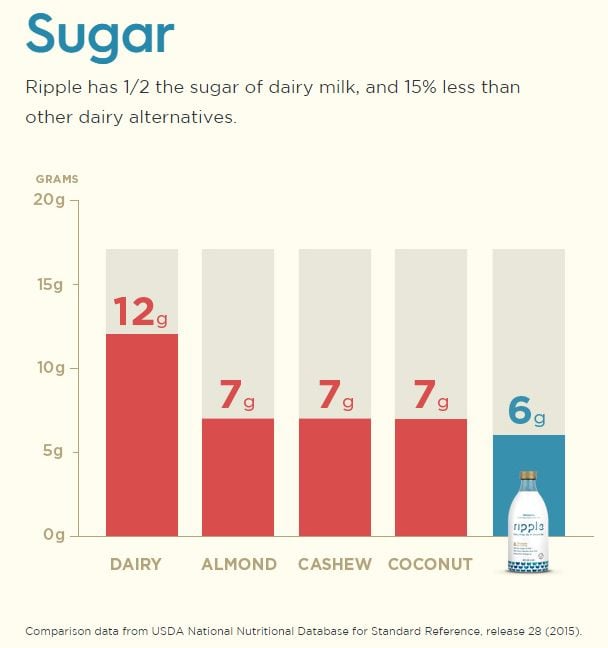
Pea protein isolate itself is readily available commercially, he explained, but if you add large quantities of it to water, add some oil and stabilizers, you won’t come up with anything like Ripple: “First, if you did this, you would not be able to incorporate very much, and second, you’d have to formulate a flavored product because it still tastes like peas.
“Protein shouldn’t really taste of anything. We wanted to take away the color and flavor so we had something bland and neutral to formulate with. The protein that goes into the milk is fairly close to white, and it ends up as a paste that is about 25% protein. The rest is essentially water. As you might imagine, we have the ability to clean it up to different levels of purity (whiteness and blandness) at different costs.”
The purification process involves a combination of pH, salts, pressure and temperature, he said: “If you buy pea protein isolate, you’ve maybe got 80-85% protein and the rest is oils and carbs and the like, and the flavor and color molecules are in that fraction, so we are basically stripping them away.”
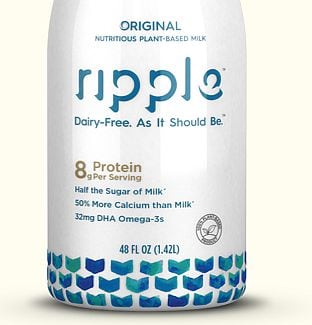
Ripple comes in original, unsweetened original, vanilla, and chocolate milk varieties.
The ingredients in the original (sweetened) version include water, pea protein, sunflower oil, organic cane sugar, algal oil, vitamins A and D, calcium phosphate, potassium phosphate, sunflower lecithin, natural flavors, sea salt, organic guar gum, and gellan gum.
It is made by blending purified yellow pea protein isolate with water, sunflower oil, and organic cane sugar, while vitamins and omega-3s are added following homogenization and sterilization.
The pea protein inside Ripple is currently sourced from yellow peas grown in France, but will shortly utilize peas grown in North America.
New products in the pipeline include plant-based yogurts, cheeses, creamers protein shakes/powders
Pea protein was chosen for the first wave of Ripple products because it is a scalable, economic protein source (it’s also non-GMO, and is not one of the big eight allergens like soy), and will provide an element of differentiation in the dairy-alternative milk market, said Renninger. However, the technology also works on other plant-based proteins.
And this is also reflected in the packaging design, which mentions peas on the back of pack, but doesn’t call them out on the front, he said. “We don’t view ourselves as a pea-based milk, we’re a plant-based milk. The technology allows us to use a variety of raw materials, and gives us the flexibility to use other on-trend ingredients in future.
“We’re also looking to develop other products including yogurts, cheeses, creamers, protein shakes and powders.”

Eight times more protein than almond milk
So what does it taste like?
Ripple is creamier and closer in flavor to dairy milk than soy and nut milks, with a less sharp and less distinct flavoring than soy, said Dr Renninger. “We’re actually not trying to precisely replicate the taste of cow’s milk, though [one reason almond milk has performed well is that some people prefer the taste to dairy milk as a standalone beverage].
“We find that people that are dairy milk drinkers really like it, and alternative dairy drinkers love it. It also works incredibly well in coffee. We’ve probably had a couple of thousand people try it and the reception has been very good.”
From a marketing perspective, while the sustainability factor is important (producing Ripple requires significantly less water than dairy or almond milk and generates fewer greenhouse gases), it’s not the primary purchase driver, says Dr Renninger, who says taste and nutrition are top of mind for shoppers, and therefore called out on the front of the pack (dairy-free, as it should be, 8g protein, half the sugar of 2% milk, 50% more calcium, 32mg DHA omega-3s).

We didn’t want to do another TetraPak with a splash of milk on the front
While almond milk has been a huge commercial success, he added, it is not as nutritious as some consumers believe, as it contains fairly small quantities of almonds, low levels of protein and can be quite sugary.
By contrast, Ripple contains eight times the protein of almond milk.
Ripple – which is packaged in 100% post-consumer recycled plastic containers – has been designed to stand out on shelf, he said.
“We didn’t want to do another TetraPak with a splash of milk on the front, we wanted something that would look really distinctive.”
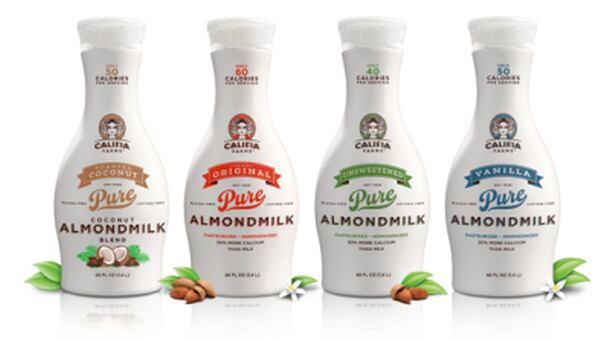
According to Nielsen data (click HERE), in the past five years, US retail sales of almond milk have grown 250% to more than $894.6m in 2015, while the total milk market shrunk by more than $1bn. Soymilk, which once dominated the dairy-alternatives market ,notched up US retail sales of $297.7m in 2015, followed by coconut milk at $61.3m,rice milk at about $18m and other substitutes (cashews, hemp, macademia, hazelnut etc) at a combined $50.2m.
High-profile backers
Last year, Lowry and Renninger attracted a cool $13.5m in venture capital funding from big guns including Khosla Ventures and Eagle Cliff Partners along with food industry icons including Seth Goldman (Honest Tea, Beyond Meat) and Gary Hirshberg (Stonyfield Farms), and may look to raise more towards the end of the year, said Dr Renninger.
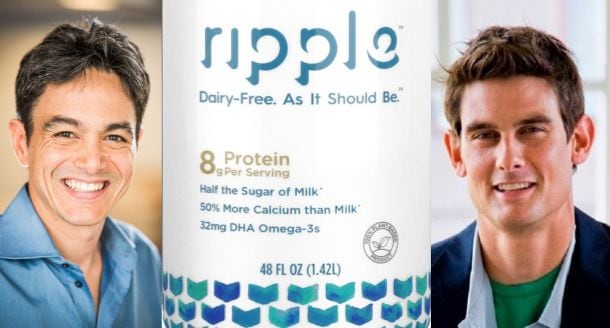
The market opportunity
So what’s the size of the dairy-free prize he and Lowry are pursuing?
“In terms of market size, the US alternatives dairy market is a $2bn market that is projected to double in the next four to five years,” said Renninger.
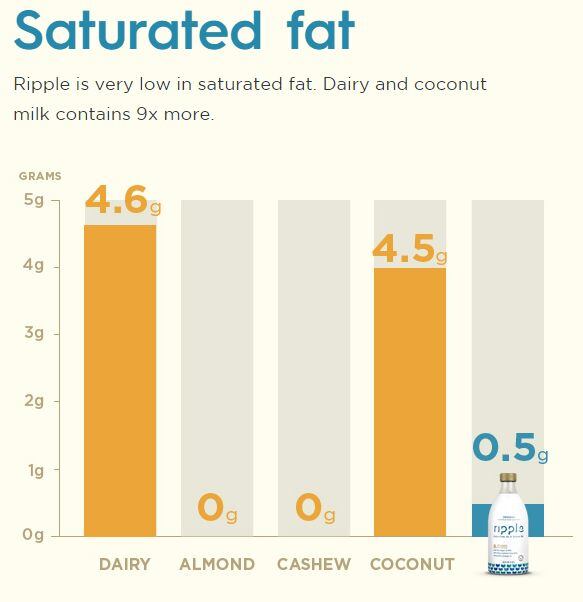
“Those projections were made without even considering the innovation that we bring to the market, so we think we could help accelerate that growth, eventually taking share from the $55bn US traditional dairy market.”
*According to Ripple Foods: "1 cup of almond milk contains 1g protein. 1 cup 2% milk contains 12g sugar and 293mg of calcium. 1 cup Ripple Original contains 8g protein, 6g sugar, & 450 mg calcium. Almond milk and milk data from USDA National Nutritional Database for Standard Reference, release 28 (2015)."
